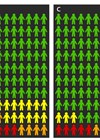Prostate cancer (PCa) represents a major public health concern and is recognised as one of the most common cancers worldwide, accounting for a significant proportion of cancer-related deaths. It is the second most common malignancy among men globally after lung cancer.
In 2018, there were 1,276,106 new cases of PCa and 358,989 deaths due to it [1]. In 2020, the global incidence rate was reported by the Global Cancer Observatory to be 1,414,259 with an estimated death rate of 375,304. A rising incidence of PCa was seen in the USA with estimated cases of 268,490 in 2022, the highest among African American men with 183.4 new cases per 100,000 individuals.
African American men also face an increased risk of developing PCa at all stages of the disease compared to Caucasian men [2]. Africa, home to the largest Black population globally, has the highest frequency of PCa diagnoses. Numerous studies have reported that among men of African descent, PCa is the dominant cancer in terms of both incidence and mortality [3]. Data from the International Agency for Research in Cancer in 2018, indicated that the age-adjusted incidence rate of PCa among African men is 845 per 100,000 persons annually. In sub-Saharan Africa, research evidence revealed that the diagnosis of PCa stands at 54 per 100,000 men annually with an estimated death rate of 20 per 1000,000 and a projected death rate of 57,048 by 2030. T
he annual death rate is expected to rise significantly from 42,298 in 2018 to 94,909 in 2040. A 124.4% rise in the next decade is predicted according to the World Health Organization (WHO), such a rise is greater than those marked for North America (+101.2%), Europe (+58.3%), and Asia (+105.6%). There is notable variation in the incidence and mortality of PCa across racial, ethnic, and geographic groups. African American men are 2.04 times more likely to die from PCa than White men. Similarly, the African Caribbean population has also been reported to have the highest incidence of PCa, at 26.3 per 100,000 compared to men of Asian ancestry with a significantly lower rate of 2.5 per 100,000.
An earlier age incidence, occurring in men under 55 years, has been reported, with one in every 350 men diagnosed in this age group. Previous autopsy reports suggest that 3% of African American men aged 20 to 30 years, 26% of men aged 30 to 39 years, and 50% of men aged 40 and 44 years had evidence of PCa. The reason could be genetic; although the extent remains unclear, it is postulated that BRCA2 carriers have a 23-fold higher risk for PCa at an early age. Africa has also reported a greater incidence rate of PCa in young people and a more aggressive type of disease compared to the high-income countries of the world.
The risk for the disease has been attributed to non-modifiable factors such as age, family history, race, and genetic mutations, as well as modifiable factors like diabetes, obesity, and smoking [4]. Others include environmental factors, lifestyle changes, infectious diseases, and dietary habits. In Africa, the population genomic, environmental factors, and infectious agents have been identified as the main factors significantly contributing to the increased risk of PCa.
The clinical and economic burden of PCa can be enormous to both patients and governments [5]. In the UK, the total annual cost for treatment of the disease was estimated at 117 million pounds, with two-to-three-fold higher figures in France and Germany. It has been reported that the total annual management cost of PCa in Eswatini, a Southern African country, is estimated to be about six million dollars [5].
The authors of this evidenced-based article set out to explore PCa risk and prognostic factors in adult men of African heritage. Searches from electronic databases were done using the Medline, Embase, Web of Sciences, Cochrane controlled trials databases, and clinicaltrial.gov for all relevant publications [6]. The literature search covered English language articles from the inception of each database up to 11 June 2024. Articles on the risk and prognostic factors of PCa in adult men of African heritage were included. Studies with mixed populations were included if at least 90% of the participants were of African heritage or had reported separate results of African men [6]. Two reviewers independently examined the titles, abstracts, and full text of the publications obtained and narrative data synthesis undertaken [6]. The evidence identified several risk factors for PCa in men of African heritage. These are outlined below.
Risk factors for prostate cancer
Age, genetic factors and family history
Most of the PCa cases were observed in older men with a mean age of 68±9.6 years, and 22% were seen in men above 75 years. Among males with C genotype risk factor, 55 years and above (OR: 2.18, 95% Cl: 1.07–4.44; P<0.05) was identified while 71.4 years (variance 14.3) was seen in Nigerian patients.
Several genetic factors were identified as risk factors for PCa in men of African heritage, and the 8q24 gene showed great significance. An admixture mapping revealed that 8q24 is highly linked to PCa risk and significant before the age of 72 years (P<0.00032) due to inheritance of African ancestry gene [7]. Analyses in another study identified that PCa risk was significantly related to two of the 17 single nucleotide polymorphisms (SNPs), situated at 3p12, and area two at 8q24, (P<0.05). Others identified SNP-SNP interactions in the CASC11-MYC-PVT1 locus, functional GSTT1 polymorphism (OR: 1.4, 95% CI: 0.7–2.5), and p53 polymorphism associated with PCa risk.
There is a positive link between PCa risk and a family history of cancer in the South African (P=0.0155) and the Guadeloupe population (P<0.001). A study observed that the variants DDR and HOXB13 were linked to a positive family history of cancer in African American men, likewise ICAM1 SNPs, 9A/C (rs5490) and K469E (rs5498) (P=0.008).
Lifestyle
Obesity is regarded as a risk factor for high-grade PCa. There is a 1.52–1.70-fold elevated risk of high-grade cancer in obese men with possession of CCR7 rs3136685 AG+GG (P=0.032) gene [8]. However, overall obesity and central obesity were revealed as intermediate-risk factors for PCa in men.
In men with a waist-to-height ratio equal to, or above 0.95, the risk for total (OR: 1.72, CI: 1.01–3.00) and high PCa were greater.
Red meat cooked at maximum temperature levels was positively linked to elevated PCa risk. Irrespective of the cooking process, neither white nor processed meat intake was linked.
A positive relationship between PCa cases and smoking habits (P<0.0001) was identified. The relationship between alcohol intake and PCa risk was also significant (P<0.0001).
The likelihood of PCa diagnosis in men who had reported 25 or more sexual partners was 2.80 (95% CI: 1.29, 6.09) higher compared to those with five or fewer partners.
Chronic aspirin intake showed a significant association with the risk of PCa (OR: 1.68, 95% CI: 1.20–2.37; P=0.0026).
Diabetes (OR: 1.83, 95% CI: 1.13–3.01; P=0.0161) and hypertension were noticed to exist among patients with PCa.
Diseases, environmental and occupational factors
The risk of PCa was 1.78-fold (95% CI: 1.13, 2.79) and 4.93-fold (95% CI: 2.79, 8.74) elevated in subjects with gonorrhoea and prostatitis infection, indicating a potential role of sexually transmitted infectious agents in the development of PCa in Black men.
On the other hand, the IFR3_rs2304206 variant interaction with sexually transmitted infectious agents’ exposure lowers the risk of PCa rather than the single existence of polymorphic gene.
Serum vitamin D deficiency of less than 20ng/mL was detected to elevate the risk of aggressive PCa disease (P=0.04). A positive linear relationship was detected between serum 25(OH)D concentration (OR: 1.23, CI: 1.01–1.49 per 10ng/mL) with PCa subjects similarly for low serum calcium (OR: 1.12, CI: 1.00–1.25 per 0.1nmol/L). The study also revealed that serum calcium and 25(OH)D may separately elevate the chances of PCa among men of African descent.
There was a reported history of exposure to ultraviolet radiation in the studied patients with both aggressive and non-aggressive forms of the PCa but a non-significant P-value of 0.09.
Serum PSA and high-grade prostatic intraepithelial neoplasia (PIN)
Elevated serum PSA>4ng/ml is positively associated with PCa (<0.0001) [9]. Men with low PSA levels (<4ng/ml) but diagnosed with high-grade PIN had significantly higher risk values than those without PIN (83.3% vs. 6.9%, P<0.0001). PSA level remained insignificant in African American men diagnosed with high PIN (83.3% vs. 92.3%, p=0.593) respectively [9].
Prognostic factors for prostate cancer
The research identified that African American PCa subjects with short leukocyte telomere length have poor prognoses.
Another study identified that the erythroblast transformation specifics dependent biomarker constitutes a standard predictive parameter for aggressive disease in PCa patients.
In Caribbean men of African descent, a low 25(OH)D level of less than 20.0ng/mL at diagnosis predicts a low survival rate for overall and PCa-specific cancer. Furthermore, Gleason score, clinically advanced stage of the disease (III and IV), lymph and vascular invasion were regarded as strong and independent prognostic factors before prostatectomy [10].
The recurrences of PCa in Black patients undergoing treatment for radical prostatectomy are not predicted by poor socioeconomic factors such as income or education. However, biological factors appear responsible for the poor outcomes and more epidemiological factors, as observed in another study.
Conclusion
The incidence of PCa is high among men of African heritage, which could be due to the lack of national screening programmes in most countries. This could impact the overall survival. The prognosis of PCa can be improved by identifying it earlier.
Some of the identifiable risk factors, such as lifestyle, diet, and sexual behaviour not related to a particular disease, are modifiable and can be prevented with proper counselling strategies adopted for non-modifiable risks like genetic factors and family history of cancer. Therefore, committed strategic policies are required, such as public health awareness on PCa and the establishment of nationwide PCa screening centres for early detection and treatment, budgetary allocation for PCa control in each nation of the globe to address this disease in men of African heritage.
TAKE HOME MESSAGES
-
Genetic factors were significantly linked to the risk of PCa in Black men due to the inheritance of the African ancestry gene, and the increased incidence of PCa in this population is highly associated with this gene rather than race.
-
Lifestyle risk factors such as obesity, smoking, alcohol, sexual activity, ingestion of properly cooked red meat, chronic aspirin usage and diseases like prostatitis and sexually transmitted infections, as well as vitamin D deficiency, were identified to be associated with increased PCa risk in Black men.
-
Elevated serum PSA>4ng/ml is associated with PCa and regarded as an established biomarker identified in many studies. High-grade PIN remains a more sensitive biomarker than PSA, significantly linked with the presence of PCa.
-
Short leukocyte telomere length, erythroblast transformation specifics dependent biomarker, vitamin D deficiency, the clinical disease state as well as epidemiological, environmental factors and infectious agents are associated with poor disease outcomes. However, variation exists between the African American population and other native Africans in terms of screening and survival outcomes due to advanced technology facilitating early diagnosis and prevention in such men.
-
Adjustment on modifiable risk factors such as obesity, sexual activity, and intake of red meat, smoking, and alcohol may assist in reducing the prevalence of PCa in men of African heritage.
References
1. Rawla P. Epidemiology of prostate cancer. World J Oncol 2019;10(2):63–89.
2. Rebbeck TR. Prostate cancer disparities by race and ethnicity: from nucleotide to neighbourhood. Cold Spring Harb Perspect Med 2018;8(9):a030387.
3. Rebbeck TR. Cancer in sub-Saharan Africa. Science 2020;367(6473):27–8.
4. Gandaglia G, Leni R, Bray F, et al. Epidemiology and prevention of prostate cancer. Eur Urol Oncol 2021;4(6):877–92.
5. Ngcamphalala C, Ostensson E, Ginindza TG. The economic burden of prostate cancer in Eswatini. BMC Health Serv Res 2022;22:483.
6. Knoll T, Omar MI, MacLennan S, et al. Key steps in conducting systematic reviews for underpinning clinical practice guidelines: methodology of the European Association of Urology. Eur Urol 2018;73(2):290–300.
7. Freedmana ML, Haimanc CA, Patterson N, et al. Admixture mapping identifies 8q24 as a prostate cancer risk locus in African American men. PNAS 2006;103(38):14068–73.
8. Dubey B, Jackson M, Zeigler-Johnson C, et al. Inflammation polymorphisms and prostate cancer risk in jamaican men: role of obesity/body size. Gene 2017;636:96–102.
9. Chornokur G, Han G, Tanner R, et al. High-grade prostate intraepithelial neoplasia (PIN) is a PSA–independent risk factor for prostate cancer in African American men: results from a pilot study. Cancer Lett 2013;331(2):154–7.
10. Yahaya JJ, Okecha T, Odida M, Wabinga H. Prognostic factors for overall survival of patients with prostate cancer in Kyadondo County, Uganda. Prostate Cancer 2020;8517130.
Declaration of competing interests: None declared.












